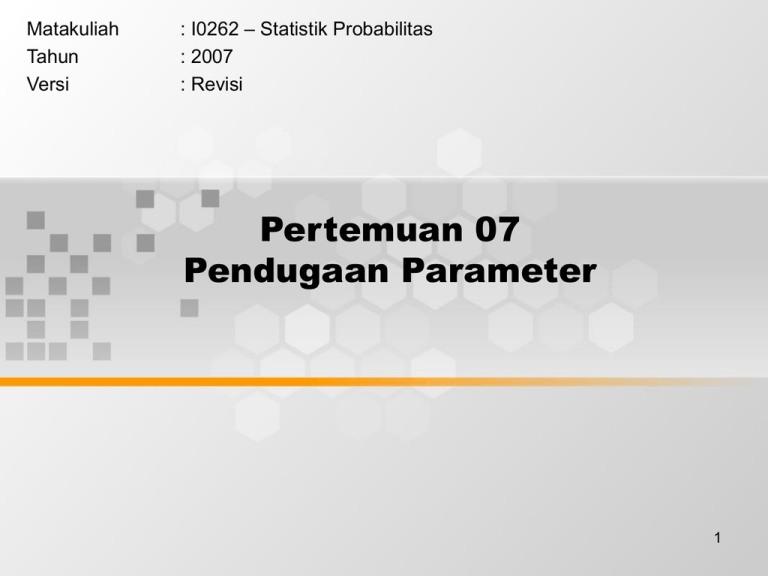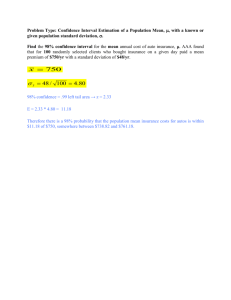Pertemuan 07 Pendugaan Parameter – Statistik Probabilitas Matakuliah
advertisement

Matakuliah Tahun Versi : I0262 – Statistik Probabilitas : 2007 : Revisi Pertemuan 07 Pendugaan Parameter 1 Learning Outcomes Pada akhir pertemuan ini, diharapkan mahasiswa akan mampu : • Mahasiswa akan dapat menghasilkan dugaan parameter, nilai tengah, proporsi dan ragam. 2 Outline Materi • Pendugaan Titik • Pendugaan Selang : nilai tengah, proporsi dan ragam. 3 Point Estimation • In point estimation we use the data from the sample to compute a value of a sample statistic that serves as an estimate of a population parameter. • We refer to x as the point estimator of the population mean . p the point estimator of the population • s is standard deviation . • is the point estimator of the population proportion p. 4 Sampling Error • The absolute difference between an unbiased point estimate and the corresponding population parameter is called the sampling error. • Sampling error is the result of using a subset of the population (the sample), and not the entire population to develop estimates. • The sampling errors are: | x | for sample mean | s - | for sample standard deviation | p p | for sample proportion 5 Interval Estimation • Interval Estimation of a Population Mean: Large-Sample Case • Interval Estimation of a Population Mean: Small-Sample Case • Determining the Sample Size • Interval Estimation of a Populationx [--------------------- x ---------------------] Proportion [--------------------- x ---------------------] [--------------------- x ---------------------] 6 Interval Estimate of a Population Mean: Large-Sample Case (n > 30) • With Known x z /2 where: n x is the sample mean 1 - is the confidence coefficient z/2 is the z value providing an area of /2 in the upper tail of the standard normal probability distribution is the population standard deviation n is the sample size 7 Interval Estimate of a Population Mean: Large-Sample Case (n > 30) • With Unknown In most applications the value of the population standard deviation is unknown. We simply use the value of the sample standard deviation, s, as the point estimate of the population standard deviation. s x z /2 n 8 Interval Estimation of a Population Mean: Small-Sample Case (n < 30) with Unknown • Interval Estimate x t /2 s n 1 - = the confidence coefficient t/2 = the t value providing an area of /2 in the upper tail of a t distribution with n - 1 degrees of freedom s = the sample standard deviation where 9 Interval Estimation of a Population Proportion • Interval Estimate p z / 2 where: p (1 p ) n 1 - is the confidence coefficient z/2 is the z value providing an area of /2 in the upper tail of the standard normal probability distribution p is the sample proportion 10 Point Estimator of the Difference Between the Means of Two Populations • Let 1 equal the mean of population 1 and 2 equal the mean of population 2. • The difference between the two population means is 1 - 2. • To estimate 1 - 2, we will select a simple random sample of size n1 from population 1 and a simple random sample of size n2 from population 2. • Let x1 equal the mean of sample 1 and x2 equal the mean of sample 2. • The point estimator of the difference between the means of the populations 1 and 2 is x1 x2 . 11 Interval Estimate of 1 - 2: Large-Sample Case (n1 > 30 and n2 > 30) • Interval Estimate with 1 and 2 Known x1 x2 z / 2 x1 x2 where: 1 - is the confidence coefficient • Interval Estimate with 1 and 2 Unknown x1 x2 z / 2 sx1 x2 where: sx1 x2 s12 s22 n1 n2 12 Interval Estimate of 1 - 2: Small-Sample Case (n1 < 30 and/or n2 < 30) • Interval Estimate with 2 Known x1 x2 z / 2 x1 x2 where: x1 x2 1 1 ( ) n1 n2 2 13 Interval Estimate of 1 - 2: Small-Sample Case (n1 < 30 and/or n2 < 30) • Interval Estimate with 2 Unknown x1 x2 t / 2 sx1 x2 where: sx1 x2 1 1 s ( ) n1 n2 2 2 2 ( n 1 ) s ( n 1 ) s 1 2 2 s2 1 n1 n2 2 14 • Selamat Belajar Semoga Sukses. 15





